Our annual airliner census reveals that growth has tailed off after a boom and turboprop fleets are expanding as small regional jets decline
The growth in the world’s airliner numbers has slowed for the second year in succession, as expansion of the fleet has begun to plateau after several years of rapid growth during the recovery after the 2001 terrorist attacks.
Flight International’s annual World Airliner Census, which is compiled from Flight’s ACAS database, reveals that the fleet of Western and Russian/CIS airliners totals 25,750 – 22,893 Western-built aircraft and 2,857 Russian/CIS aircraft.
In the recovery after 9/11, the annual growth of the world fleet rose as high as 5% following the stagnant 2002-3 period in the immediate aftermath of the attacks. Growth fell to 2.7% last year and has dropped to 1.8% for the past 12 months.
The Western-built airliner fleet has grown by 2.1% over the past 12 months (compared with 3.7% in 2005), while the Russian/CIS built fleet fell by 0.5% – significantly less than the 2.7% decline experienced the year before.
During the 12 months between the two fleet samples, 970 aircraft have been delivered – around 2% more than last year. Western deliveries rose by 2.1% to 967, while Russian/CIS shipments have almost halved from 11 to six units.
Early indications are that the number of “retirements” (aircraft destroyed and permanently withdrawn) has declined during the past 12 months, from 330 during 2004-5 to 290 aircraft, although the long-term status of parked aircraft (whether they will be returned to service or not) makes the true number of retirements notoriously difficult to ascertain in the short term.
Fewer retirements
The number of Western-built airliner retirements dropped by 7% to 253, while the tally of Russian/CIS aircraft being withdrawn is down by over a third to 34.
In overall terms, while North/South America continues to represent the majority of the overall census fleet, its domination has declined this year from 43.6% to 42.4%, thanks to another one percentage point gain by Asia, Australasia and the Middle East. The latter region’s fleet broke through the 5,000 threshold this year and is 5,219 aircraft. The proportions held by Europe and Africa are little changed from 2005, at 31.7% and 5.6%, respectively.
In terms of aircraft types, the top 10 mainline airliner ranking is still headed by the Airbus A320 family, although its main rival, the Boeing 737-600/700/800/900 is closing rapidly. At over 15%, the latter fleet had the highest growth of all during the last 12 months – catapulting it ahead of the 737-300/400/500 Classic into second place, although it is still 860 units shy of its rival. Despite declines by the fleets of older 737s (Classic and -100/200), the overall in-service tally for this best-selling twinjet grew significantly again this year and now stands at 4,328 units.
Another mainline type that experienced significant growth this year is the Boeing 777. Although still ranked tenth, a double-digit increase resulted in its fleet rising to 575 aircraft. Next year the 777 is expected to climb past the 737-100/200 and possibly the 727.
The regional aircraft ranking shows no change in terms of the order, but turboprops have a higher growth rate than regional jets.
Shuddering halt
While 50-seat regional jets still occupy the top two positions (the Bombardier CRJ100/200 at the helm followed by the Embraer ERJ-145 family), the rapid fleet growth of these aircraft has come to a shuddering halt (the CRJ fleet has actually declined). Meanwhile, the turboprop Dash 8/Q Series fleet has grown by almost 5% – double that of last year.
The decline in the CRJ100/200 fleet reflects the overcapacity issue that has blighted regional operators this year. The census only includes aircraft with airlines, and so the decline reflects the fact that a number of aircraft have been returned to lessors – for example the Independence Air fleet of 63 aircraft.
The Russian/CIS types ranking is headed by the Antonov An-24 turboprop this year – 12 months ago it shared top spot with the Tupolev Tu-154, which has dropped to the runners-up position.
Given the record sales year experienced by Airbus and Boeing in 2005, unsurprisingly the airliner order backlog has grown by one-third, to 4,400 aircraft. In tandem with the order surge, Asia, Australasia and the Middle East has vaulted ahead of North/South America with a commanding 39.9% share – a six percentage point rise. North/South America’s tally has grown little, resulting in its share declining from 38% last year to 30% this year.
In the order race between Boeing has leap-frogged its rival and now holds a slim lead. Between them, they have over 3,700 orders – up over 40% since 2005.
Asia, Australasia and the Middle East is the largest market, with Airbus marginally ahead of Boeing. Unsurprisingly, each airframer leads in its home market – Boeing has over third more of the North/South America market, while the European manufacturer leads in Europe with 66% more orders. However, any detailed analysis into the regional breakdowns is skewed by the fact that customers for over 100 of Boeing’s orders are undisclosed.
During the past 12 months, the proportion of parked aircraft has stabilised at around 9.8% of the total Western-built airliner fleet (around 1,800 aircraft). This year’s census includes a longer-term trend analysis that looks back at the annual total over the six years before 9/11, which shows that while proportionally the parked fleet is at its lowest level since 2002, it is still more than double that of the pre-9/11 tally.
Boeing retains its lead of the manufacturer fleet, but a high proportion of its tally is represented by ageing aircraft, the retirement of which offsets the production of new aircraft. Consequently, Boeing’s fleet grew by less than 1% last year to 10,700 aircraft, while Airbus consolidated its second place with 10% growth, pushing its total through the 4,000 aircraft threshold, which increased its market share by 1% to 18%.
Fourth-placed Embraer was the second fastest grower over the past 12 months with a 9.2% rise, while is rival Bombardier saw its growth collapse to less than 2%, compared with more than 8% last year. ■

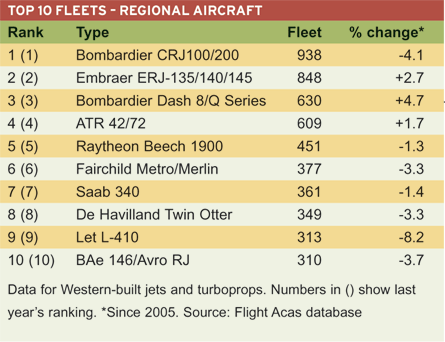
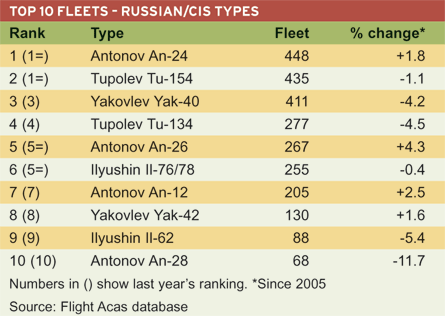
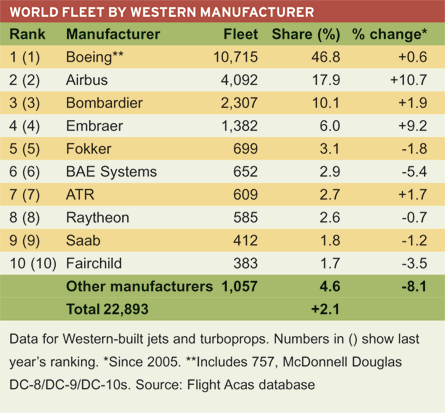

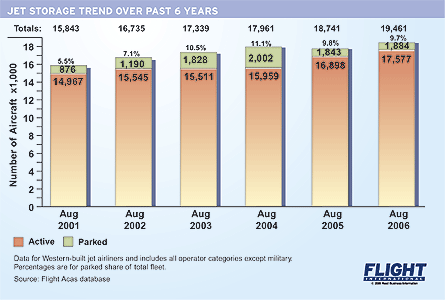
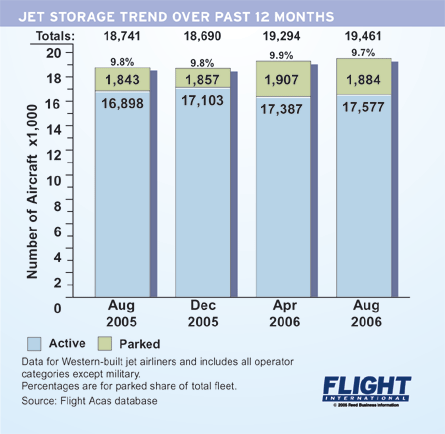
Source: Flight International



















